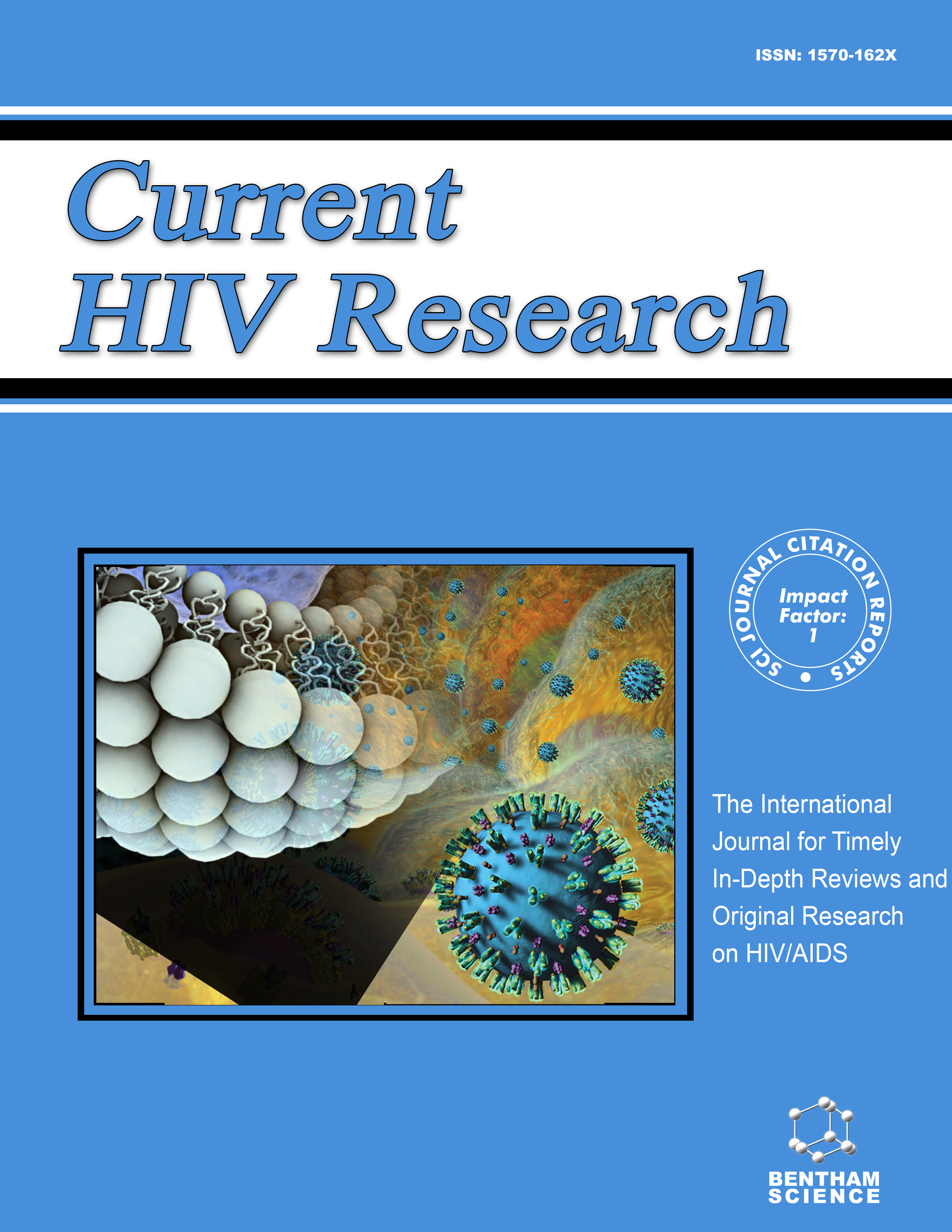- Home
- A-Z Publications
- Current HIV Research
- Previous Issues
- Volume 9, Issue 3, 2011
Current HIV Research - Volume 9, Issue 3, 2011
Volume 9, Issue 3, 2011
-
-
Application of SCR Priming VLP Boosting as a Novel Vaccination Strategy Against HIV-1
More LessHuman immunodeficiency virus infection is a worldwide health problem and a protective vaccine is desperately needed to control the AIDS pandemics. To address this concern, we previously constructed single-cycle replicable (SCR) HIV-1 virions, which completely maintained the antigenic structures of HIV-1. Herein, to optimize a vaccination strategy, we studied the immunogenicity of produced SCR virions and adj Read More
-
-
-
HIV Persistence in the Gut Mucosa of HIV-Infected Subjects Undergoing Antiretroviral Therapy Correlates with Immune Activation and Increased Levels of LPS
More LessWe investigated the relationship between viral persistence in the gut, microbial translocation, and T cell activation during chronic HIV infection. Plasma levels of LPS, fraction of circulating CD8+CD38+ T cells, and levels of HIV-DNA in rectosigmoid biopsies and peripheral blood mononuclear cells were determined in 22 HIV-infected individuals and 10 healthy controls. We found that in untreated HIV-infected individuals, HIV-DN Read More
-
-
-
Drug Resistance Mutations During Structured Interruptions of HAART in HIV-1 Infected Children
More LessInformation concerning structured treatment interruptions (STI) of the Highly Active Antiretroviral Therapy (HAART) and the associated risk of this strategy for selecting antiretroviral resistance in children is scarce. In this study, we have searched for antiretroviral resistance mutations at the end of five viral rebounds of two HIV-1-infected children who underwent an STI program. The HAART of two children with HIV and a chro Read More
-
-
-
Prospective Observation for Seven-Year's Highly Active Antiretroviral Therapy in Chinese HIV-1 Infected Patients
More LessAuthors: Mei He, Yu-Huang Zheng, Hua-Ying Zhou, Diallo Mamadou, Zi Chen, Xia Chen, Yun-Hai Yao and Yan HeTo prospectively observe the efficacy, tolerability, immune reconstitution and toxicity of long-term highly active antiretroviral therapy (HAART) in Chinese patients infected HIV. 437 cases originally received two nucleoside reverse transcriptase inhibitors (NRTIs) and one non-nucleoside reverse transcriptase inhibitor (NNRTI) during a mean period of 4.3 years (3.1-7.3). Patients were followed up by HIV RNA levels, T lymphocyte s Read More
-
-
-
Once-a-Day (QD) vs Twice-Daily (BID) Nevirapine as Simplification in PITreated Patients After 2 mos. of BID Induction
More LessTo assess the efficacy and the tolerability of once-daily (QD) versus twice-daily (BID) nevirapine (NVP)-based highly active antiretroviral therapy (HAART) in virologically suppressed, HIV-positive patients switched from protease inhibitor (PI)-based HAART. Eligible patients were enrolled in the multicenter trial if HIV RNA levels were <50 copies/mL for ≥6 months prior. Patients were switched from a PI to NVP 200 mg BID for 2 m Read More
-
-
-
Neutral Actions of Raltegravir on Adipogenesis, Glucose Metabolism and Lipolysis in 3T3-L1 Adipocytes
More LessAuthors: Patricia Perez-Matute, Laura Perez-Martinez, Jose R. Blanco and Jose A. OteoRaltegravir (RAL) has been shown to be virologically effective in both treatment naive and triple class resistant patients. A more favourable metabolic profile associated with RAL in comparison with other antiretroviral drugs has also been observed. The aim of this study was to investigate the molecular mechanisms that could explain the lack of toxicity of this drug in metabolism. Thus, the effects of RAL on adipogenesis an Read More
-
-
-
Cervical Squamous Intraepithelial Lesions Among HIV-Positive Women on Antiretroviral Therapy in Kenya
More LessBackground: The prevalence of cervical squamous intraepithelial lesions (SIL) among HIV-infected women on antiretroviral therapy in sub-Saharan Africa has not been well described. Methods: HIV-infected women enrolled in an HIV treatment clinic in Nairobi, Kenya were offered free cervical screening with Papanicolaou (Pap) smear testing if they were 30 to 39 years of age and on antiretroviral therapy. Women with SIL were Read More
-
-
-
Liver-Related Factors Associated with Low Vitamin D Levels in HIV and HIV/HCV Coinfected Patients and Comparison to General Population
More LessObjectives: Low 25-Hydroxyvitamin D (25[OH]D) was associated with severe fibrosis and low sustained virological response (SVR) after interferon (IFN)-based therapy in chronic hepatitis C. Furthermore, hypovitaminosis D was reported in HIV-infected individuals, but its role in liver disease progression in HIV/HCV coinfection is unknown. Methods: 25(OH)D was retrospectively measured in 237 HIV-infected patients (93 with H Read More
-
-
-
Canada's International Response to HIV during Times of Global Transition: A Qualitative Inquiry
More LessBackground: Canada's international response to HIV may be under threat given CIDA's new aid priorities that appear to exclude health. Drivers of this recent priority shift have included the influence of global aid trends among public sector donors and changes within the global HIV milieu itself. However, this is not the first time Canada has shifted in response to these two global trends. The era from 2000-2004 also witnessed dra Read More
-
Volumes & issues
-
Volume 23 (2025)
-
Volume 22 (2024)
-
Volume 21 (2023)
-
Volume 20 (2022)
-
Volume 19 (2021)
-
Volume 18 (2020)
-
Volume 17 (2019)
-
Volume 16 (2018)
-
Volume 15 (2017)
-
Volume 14 (2016)
-
Volume 13 (2015)
-
Volume 12 (2014)
-
Volume 11 (2013)
-
Volume 10 (2012)
-
Volume 9 (2011)
-
Volume 8 (2010)
-
Volume 7 (2009)
-
Volume 6 (2008)
-
Volume 5 (2007)
-
Volume 4 (2006)
-
Volume 3 (2005)
-
Volume 2 (2004)
-
Volume 1 (2003)
Most Read This Month
Article
content/journals/chr
Journal
10
5
false
en


